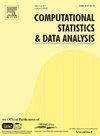Co-clustering multi-view data using the Latent Block Model
IF 1.6
3区 数学
Q3 COMPUTER SCIENCE, INTERDISCIPLINARY APPLICATIONS
引用次数: 0
Abstract
The Latent Block Model (LBM) is a prominent model-based co-clustering method, returning parametric representations of each block-cluster and allowing the use of well-grounded model selection methods. Although the LBM has been adapted to accommodate various feature types, it cannot be applied to datasets consisting of multiple distinct sets of features, termed views, for a common set of observations. The multi-view LBM is introduced herein, extending the LBM method to multi-view data, where each view marginally follows an LBM. For any pair of two views, the dependence between them is captured by a row-cluster membership matrix. A likelihood-based approach is formulated for parameter estimation, harnessing a stochastic EM algorithm merged with a Gibbs sampler, while an ICL criterion is formulated to determine the number of row- and column-clusters in each view. To justify the application of the multi-view approach, hypothesis tests are formulated to evaluate the independence of row-clusters across views, with the testing procedure seamlessly integrated into the estimation framework. A penalty scheme is also introduced to induce sparsity in row-clusterings. The algorithm's performance is validated using synthetic and real-world datasets, accompanied by recommendations for optimal parameter selection. Finally, the multi-view co-clustering method is applied to a complex genomics dataset, and is shown to provide new insights for high-dimension multi-view problems.
使用潜在块模型的多视图数据共聚类
潜在块模型(Latent Block Model, LBM)是一种突出的基于模型的共聚类方法,它返回每个块聚类的参数表示,并允许使用基础良好的模型选择方法。尽管LBM已经适应了各种特征类型,但它不能应用于由多个不同的特征集(称为视图)组成的数据集,用于一组共同的观察结果。本文引入了多视图LBM,将LBM方法扩展到多视图数据,其中每个视图边缘跟随一个LBM。对于任意一对两个视图,它们之间的依赖关系由行-簇隶属矩阵捕获。基于似然的方法用于参数估计,利用与吉布斯采样器合并的随机EM算法,同时制定了ICL标准来确定每个视图中的行和列簇的数量。为了证明多视图方法的应用是合理的,制定了假设检验来评估跨视图的行簇的独立性,测试过程无缝集成到估计框架中。引入了一种惩罚方案来诱导行聚类的稀疏性。该算法的性能使用合成和现实世界的数据集进行了验证,并提供了最佳参数选择的建议。最后,将多视图共聚类方法应用于复杂的基因组数据集,并为高维多视图问题提供了新的见解。
本文章由计算机程序翻译,如有差异,请以英文原文为准。
求助全文
约1分钟内获得全文
求助全文
来源期刊

Computational Statistics & Data Analysis
数学-计算机:跨学科应用
CiteScore
3.70
自引率
5.60%
发文量
167
审稿时长
60 days
期刊介绍:
Computational Statistics and Data Analysis (CSDA), an Official Publication of the network Computational and Methodological Statistics (CMStatistics) and of the International Association for Statistical Computing (IASC), is an international journal dedicated to the dissemination of methodological research and applications in the areas of computational statistics and data analysis. The journal consists of four refereed sections which are divided into the following subject areas:
I) Computational Statistics - Manuscripts dealing with: 1) the explicit impact of computers on statistical methodology (e.g., Bayesian computing, bioinformatics,computer graphics, computer intensive inferential methods, data exploration, data mining, expert systems, heuristics, knowledge based systems, machine learning, neural networks, numerical and optimization methods, parallel computing, statistical databases, statistical systems), and 2) the development, evaluation and validation of statistical software and algorithms. Software and algorithms can be submitted with manuscripts and will be stored together with the online article.
II) Statistical Methodology for Data Analysis - Manuscripts dealing with novel and original data analytical strategies and methodologies applied in biostatistics (design and analytic methods for clinical trials, epidemiological studies, statistical genetics, or genetic/environmental interactions), chemometrics, classification, data exploration, density estimation, design of experiments, environmetrics, education, image analysis, marketing, model free data exploration, pattern recognition, psychometrics, statistical physics, image processing, robust procedures.
[...]
III) Special Applications - [...]
IV) Annals of Statistical Data Science [...]
 求助内容:
求助内容: 应助结果提醒方式:
应助结果提醒方式:


